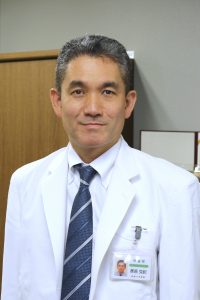Recent trends in the treatment of community-acquired pneumonia: A Japanese perspective

Professor Katsunori Yanagihara
Professor and Chairman, Department of Laboratory Medicine, Nagasaki University Graduate School of Biomedical Sciences;
Head, Laboratory Medicine, Nagasaki University Hospital;
Vice Dean, School of Medicine, Nagasaki University,
Japan
Antimicrobial resistance (AMR) is a global health threat. Japan published its National Action Plan on AMR in April 2016 – outlining specific targets for antibiotic use reduction by 2020.1 A latest update reported antibiotic use reductions of 10.9% for total antimicrobials, 22.7% for cephalosporins, 18.1% for fluoroquinolones, and 20.6% for macrolides in 2019 relative to 20132.
Professor Katsunori Yanagihara shares insights into the current antibiotic resistance trends in community-acquired pneumonia (CAP) in Japan.
Q1. Please describe the aetiology and epidemiology profile of CAP and aspiration pneumonia in Japan.
Three causative pathogens of CAP remain to be common today: Streptococcus pneumoniae, Haemophilus influenzae, and Mycoplasma pneumoniae. Other common pathogens include Staphylococcus aureus, Klebsiella pneumoniae and Chlamydia (C. pneumoniae and C. psittaci), and rarely, Escherichia coli and Legionella pneumophila3.
The causes of aspiration pneumonia include oral anaerobic bacteria (Streptococcus and Fusobacterium spp.) in addition to the CAP pathogens.
Pneumonia is more common in the elderly, because of the high prevalence of aspiration in people over 65 years old. There are more cases from autumn to winter with co-infections involving influenza and respiratory tract infections being common. Pneumonia associated with illnesses such as influenza tend to become more severe.
As the elderly population expands in Asian countries like in Japan, the number of patients with pneumonia will surely increase. Given the high rate of mortality with pneumonia in the elderly, this is something we must pay attention to.
Q2. Please describe the antibiotic resistance trends/patterns among CAP pathogens in Japan – particularly macrolide-resistance among CAP pathogens.
S. pneumoniae has developed resistance to many drugs including penicillins, cephems, and macrolides. About 50% of S. pneumoniae isolates are resistant to penicillin and up to 90% are resistant to macrolides4. Thus, one can say that most S. pneumoniae-induced pneumonia can no longer be treated using macrolides.
H. influenzae is hard to treat effectively with penicillins and cephems. The rate of β-lactamase-producing bacteria and β-lactamase non-producing ampicillin-resistant H. influenzae reaches 50–60%,4 and this is trending upwards.
Macrolide resistance in M. pneumoniae fluctuates, but there is no doubt that resistance exists.
Q3. How has the emergence of macrolide-resistant pathogens affected the way clinicians approach patients with CAP?
I believe there has been a large effect. In the past, many doctors in Japan have relied on macrolides, which likely contributed to the increase in AMR in S. pneumoniae and M. pneumonia. AMR has now become widely known, and it is recognised that pneumonia cannot be treated with macrolides. In particular, doctors no longer use macrolides to treat elderly patients with pneumonia. Macrolides may still be used in young patients if atypical pneumonia, such as those caused by M. pneumoniae, is suspected.
Q4. What is the role of fluoroquinolones – particularly sitafloxacin – in the emergence of such resistance?
Sitafloxacin (STFX) is a respiratory quinolone with superior characteristics. Respiratory quinolones have strong antibiotic activity against all major CAP pathogens (S. pneumoniae, H. influenzae, and M. pneumoniae). On the other hand, only 60% coverage can be expected of β-lactam antibiotics such as penicillins and cephems, and likewise of macrolides. Thus, we can say that respiratory quinolones can be confidently prescribed for CAP.
STFX has extremely strong antibiotic activity against S. pneumoniae, the most common CAP pathogen, and there is data to show that emergence of resistance in S. pneumoniae was about 1000 times less frequent for STFX than for other new quinolones.5 As mentioned above, it is especially important to manage aspiration pneumonia among CAP. This means it is critical for the drug to be effective against anaerobic bacteria. STFX has very strong antibiotic activity against anaerobic bacteria and it can be expected to be an effective treatment for aspiration pneumonia.
Q5. Recently, aspiration pneumonia is attracting attention in light of the expanding elderly population in Japan. What are the empirical treatment strategies for the management of aspiration pneumonia? How can the management of aspiration pneumonia among elderly patients be improved?
Diagnosis and treatment in the early stages is important for pneumonia in the elderly. Regarding diagnosis, clinical symptoms such as fever, cough, and sputum may not present clearly in elderly patients, so it is important to proactively suspect pneumonia and apply treatment when poor physical conditions, loss of appetite, and loss of vigour are observed. Appropriate antibiotics should be used in the early stages to prevent severe disease. I think it is important to prescribe a medicine like STFX that has strong antibiotic activity and is effective for both S. pneumoniae and anaerobic bacteria.
Regarding general prevention of aspiration pneumonia, it is important to follow the guidance of medical personnel regarding lifestyle habits to prevent aspiration such as eating food that is difficult to aspirate and avoiding lying down immediately after eating.
I believe that thinking of treatments that prevent the induction of AMR is a way to improve current treatment strategies. In an era of AMR, prescribing drugs with strong antibacterial activity would be a prerequisite, but it is also important to think about future patients, and to avoid inducing AMR. In this sense, STFX is an excellent choice as it not only has strong activity but also is less likely to give rise to resistant pathogen strains.
Q6. Please tell us about your experience with sitafloxacin.
Generally, I prescribe STFX for all outpatients with pneumonia (most are aspiration pneumonia in elderly patients) who can eat. Even nearly moderate pneumonia can be cured this way in elderly patients. Adequate clinical efficacy can be observed in most patients within the first week.
Q7. Finally, can you please give some advice?
Twenty years ago, there was debate about whether to use new quinolones for S. pneumoniae. There were fears that it would lead to an increase in drug-resistant bacteria. However, there has been no such increase to date. Furthermore, among the new quinolones, STFX is less likely to induce drug-resistant bacteria. Therefore, I think that it is important to use respiratory quinolones such as STFX as the first-choice drug for the treatment of CAP and aspiration pneumonia.
References
- Kusama Y, et al. Int J Infect Dis 2021;103:154-6.
- Nippon AMR One Health Report. 2020. Available at: https://www.mhlw.go.jp/content/10900000/000715546.pdf Accessed: October 2021
- The Japanese Respiratory Society. The JRS Guidelines for the Management of Pneumonia in Adults 2017. Available at: https://www.jrs.or.jp/ Accessed: October 2021
- Yanagihara K, et al. J Infect Chemother 2017;23:587-97.
- Gracevit® tablet and fine granules. Summary of Pharmacological Studies. Available at: https://www.pmda.go.jp/drugs/2008/P200800006/430574000_22000AMX00015_H103_2.pdf Accessed: October 2021










